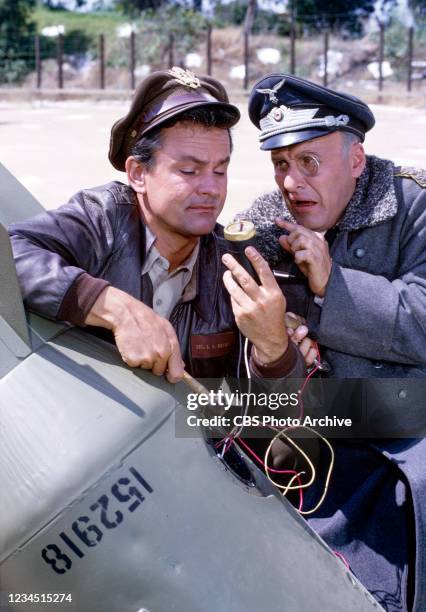What’s a German General doing in the middle of a fiery inferno, and what does it have to do with a band of audacious Allied prisoners of war? The seemingly absurd scene, straight out of the iconic television comedy “Hogan’s Heroes,” has captivated viewers for decades. But beyond the slapstick humor and clever escapes, the burning of General Hammerschlag, one of the show’s recurring villains, holds a captivating mystery of its own: How could an event so seemingly catastrophic happen within a prisoner of war camp, and why did it become such a central plot point for the series?

Image: www.gettyimages.com
Though it may seem like a simple, comedic misunderstanding in the show’s world, the burning of General Hammerschlag offered a window into the show’s deeper themes. It went beyond mere escape shenanigans to explore the complexities of war, power dynamics, and the ever-present struggle between good and evil. Understanding the circumstances of this infamous event reveals a deeper layer of the show, one that offers more than just a chuckle. Let’s dive into the intrigue surrounding this fiery incident, unraveling the layers between its comedic facade.
The Origins of a Mystery: Setting the Stage for Hammerschlag’s Fate
To understand the burning of General Hammerschlag, we must first acknowledge his impact in the world of “Hogan’s Heroes.” General Wilhelm Hammerschlag was introduced in the second season as a stern and ruthless Nazi General, known for his unwavering loyalty to the Führer and his relentless efforts to prevent the Allies’ escape. His appearances often brought heightened tension and danger to Camp Stalag 13, creating an interesting dynamic for the series’ writers to explore.
The “Hogan’s Heroes” world, though fictional, was grounded in a reflection of the real experiences of Allied prisoners of war during World War II. While the show’s premise hinges on the seemingly impossible notion of prisoners actively outwitting their captors, it also offered a glimpse into the realities of wartime. The characters faced the constant threat of punishment, the chilling presence of Nazi authority, and a palpable sense of uncertainty regarding their future.
A Twist of Fate: The Fire that Ignited Hammerschlag
The infamous burning of Hammerschlag is depicted in the Season 4 episode, “General Hammerschlag’s Last Stand.” This episode weaves a narrative that both mocks and reflects the real-life horrors of war, showcasing the absurdity of war while also acknowledging its serious consequences. The episode begins with Hammerschlag arriving at Stalag 13, believing he’s coming to assume command of the camp after a scandal involving the previous commandant, a thinly veiled critique of the Nazi regime’s internal power struggles.
Colonel Hogan and his team, ever the resourceful rebels, orchestrate a cunning plan to make Hammerschlag believe that Camp Stalag 13 is under attack by the Russians. As Hammerschlag desperately tries to defend the camp using a variety of seemingly ridiculous tactics, including a flamethrower, he inadvertently sets himself ablaze. The scene is both humorous and unsettling, showcasing the precarious nature of war while simultaneously mocking the incompetence of the Nazi leadership.
Beyond the Comedy: Exploring the Underlying Themes
The burning of Hammerschlag might seem like a slapstick scene at first glance, but its significance extends beyond the humor. The episode serves as a commentary on the dangers of arrogance and hubris, often found in positions of power. Hammerschlag’s blind ambition leads to his downfall, a subtle message against the very system of Nazi power that fueled the war. The episode also highlights the absurdity of war, showcasing the ludicrous lengths to which people in power will go, not simply to win, but to maintain their positions.
The episode also taps into the very real fear and uncertainty faced by Allied prisoners of war. The tension between hope and despair, the relentless pursuit of freedom, and the constant threat of violence are woven into the scene, highlighting the complexities of war’s impact on the human spirit. Hammerschlag’s demise, though comical in execution, serves as a reminder of the cost of war, both for the victors and the vanquished. The episode provides an unsettling, albeit comedic, lens through which to examine the toll war takes on individuals and the world at large.

Image: www.alamy.com
A Legacy of Laughter and Reflections: Hammerschlag’s Burning in Popular Culture
The burning of General Hammerschlag went beyond the episode itself, becoming a memorable part of “Hogan’s Heroes” lore. The scene was referenced in other episodes, with various characters jokingly recalling the incident, reinforcing its cultural relevance within the show’s world. The scene also found its way into popular culture, quoted by fans and becoming a meme in its own right, signifying the show’s enduring popularity and the lasting impact of its humorous, yet thought-provoking, storylines.
Despite being a fictional comedy, “Hogan’s Heroes” managed to touch upon real-life themes, offering a unique lens through which to explore the realities of wartime life. The burning of General Hammerschlag, while perhaps absurd in its execution, served as a reminder that even in the midst of war, there is space for humor, and even a moment of comic relief can touch upon profound truths.
Hogan’S Heroes Is General Hammerschlag Burning
Concluding Thoughts: A Legacy of Laughter and Intrigue
The burning of General Hammerschlag in “Hogan’s Heroes” is more than just a comedic scene. It’s an event that showcases the show’s unique balance of humor, satire, and historical relevance. The scene offers a reflection on the intricacies of war, the dangers of misguided power, and the enduring hope that even in the darkest of times, there is space for humor and resilience. While the episode may have been intended for entertainment, it inadvertently gave us a glimpse into the depths of human nature and the complex struggles of war, proving that even the most lighthearted moments can hold profound meaning.





